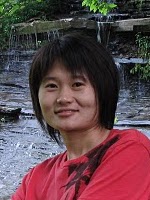Past NIMBioS Postdoctoral Fellow
Juanjuan "JJ" Chai
 Dates: August 2011 – August 2013
Dates: August 2011 – August 2013
Project Title: Identifiability of statistical models and consistency of maximum parsimony in phylogenetics
As a NIMBioS postdoctoral fellow, JJ Chai (Ph.D. Mathematics, Indiana Univ. Bloomington, 2011) conducted research on solving problems related to maximum parsimony in phylogenetics and the identifiability of phylogenetic models. Chai's primary project was building a mechanistic model of amino acid sequences evolution, dubbed "SAC" (selection on amino acids and codons). The novelty about this model is that it takes into account both population genetics and phylogenetics, making the model more biologically informative. For a substitution of amino acid in a sequence to take place in SAC, it has to start with a mutation, which is fixed (or lost) in the evolutionary process with a probability that depends on the fitness of the mutated amino acid and the wild type amino acid. The mutation rates between amino acid are affected by the codon structure and nucleotide mutation rates, and the fitness of an amino acid is determined by its physiochemical properties. This new model outperforms other empirical models of amino acid substitution substantially, based on the Akaike Information Criterion and model adequacy test. Simulated sequences under the new model are much closer than those under the empirical models. From the sequences observed, we were able to reconstruct the evolutionary history and make good inference about the optimal amino acid sequences. The new model also shed light on the local optima problem in the fitness landscape; namely evolution sometimes prefers the sub-optimal state than the global optimal state.
Upon completing her fellowship at NIMBioS, Dr. Chai accepted a position as a postdoctoral fellow in supercomputing at Oak Ridge National Laboratory.
NIMBioS Seminar: On the number of binary characters needed to recover a phylogeny using maximum parsimony
Feature Story: Explorations through time: Chai charts the course of evolutionary history
Video Interview:
Parsimony in phylogenetics
Presentations while at NIMBioS
Identifiability of GTR + Γ + I model, Contributed presentation at the Joint Statistical Meetings, Aug, 2011.
Number of Binary Characters Needed to Recover a Phylogeny Using Maximum Parsimony, Nov 8, 2011, NIMBioS seminar.
Two pathway models for crossover interference, Feb 13, 2012, Job talk at Merck Beijing.
New mechanistic model of protein evolution on amino acid level, Nov 2, 2012, Outreach activity of NIMBioS at University of Texas at El Paso.
New mechanistic model of protein evolution on amino acid level, Nov 7, 2012, Department of Ecology and Evolutionary Biology at Univ. of Tennessee.
Education, Outreach and Training
REU program: co-mentored the group "Investigate protein evolution and codon usage bias" with Dr. Michael Gilchrist, summer 2012.
Assisted Dr. Dennis Pearl for lab demonstration and group project in graduate workshop at Mathematics Biosciences Institute in Ohio State University, summer 2012. Topic: Phylogenetics.
Assisted graduate workshop at NIMBioS, summer 2013. Topic: Hierarchical Bayesian approach to investigate the conductivity of plants.
Participated in grant writing workshops at Univ. of Tennessee; job discussion at NIMBioS; phylogenetics discussion group; joint lab meetings in Dr. Brian O'Meara's lab in Department of Ecology and Evolutionary Biology at Univ. of Tennessee.
NIMBioS
1122 Volunteer Blvd., Suite 106
University of Tennessee
Knoxville,
TN 37996-3410
PH: (865) 974-9334
FAX: (865) 974-9461
Contact NIMBioS


